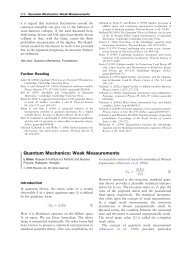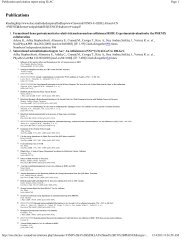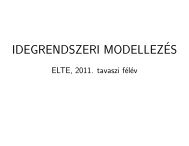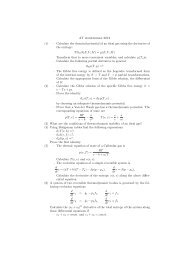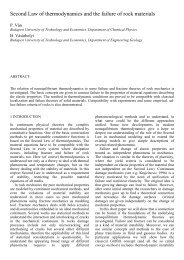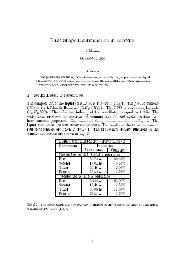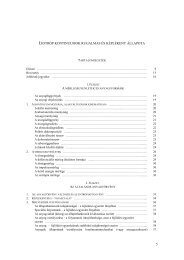Gauge/gravity duality: an overview Z. Bajnok
Gauge/gravity duality: an overview Z. Bajnok
Gauge/gravity duality: an overview Z. Bajnok
You also want an ePaper? Increase the reach of your titles
YUMPU automatically turns print PDFs into web optimized ePapers that Google loves.
Seminar, December 7, 2012, Bratislava<br />
<strong>Gauge</strong>/<strong>gravity</strong> <strong>duality</strong>: <strong>an</strong> <strong>overview</strong><br />
Z. <strong>Bajnok</strong><br />
MTA-Lendület Holographic QFT Group<br />
Wigner Research Centre for Physics, Budapest<br />
The Illusion of Gravity - Ju<strong>an</strong> Maldacena, Scientific Americ<strong>an</strong> (2005)<br />
1
Motivation: Feynm<strong>an</strong>’s legacy<br />
Richard P. Feynm<strong>an</strong><br />
(1918–1988)<br />
What I c<strong>an</strong>not create I do not underst<strong>an</strong>d.<br />
Know how to solve every problem that has been solved.<br />
To learn: Bethe Ansatz Probs., ← Kondo, 2D Hall, accel<br />
temp, Non linear classical Hydro<br />
1965<br />
Qu<strong>an</strong>tumelectrodynamics:<br />
Feynm<strong>an</strong> graphs<br />
Strong interaction?<br />
2
Motivation: Org<strong>an</strong>izing matter<br />
3
Motivation: Org<strong>an</strong>izing matter
Motivation: Org<strong>an</strong>izing matter<br />
Electric interaction (potential Φ(r) = k Zq<br />
r )<br />
Qu<strong>an</strong>tum mech<strong>an</strong>ics (Schrödinger eq.) HΨ = (− (∇)2<br />
2m<br />
+ Φ(r))Ψ = E Ψ
Motivation: Org<strong>an</strong>izing matter<br />
Electric interaction (potential Φ(r) = k Zq<br />
r )<br />
Qu<strong>an</strong>tum mech<strong>an</strong>ics (Schrödinger eq.) HΨ = (− (∇)2<br />
2m<br />
+ Φ(r))Ψ = E Ψ
Motivation: Org<strong>an</strong>izing matter<br />
Electric interaction (potential Φ(r) = k Zq<br />
r )<br />
Qu<strong>an</strong>tum mech<strong>an</strong>ics (Schrödinger eq.) HΨ = (− (∇)2<br />
2m<br />
+ Φ(r))Ψ = E Ψ
Org<strong>an</strong>izing matter II<br />
Brookhaven: Relativistic heavy ion collider (gold ion)<br />
4
Org<strong>an</strong>izing matter II<br />
Brookhaven: Relativistic heavy ion collider (gold ion)
Org<strong>an</strong>izing matter II<br />
Brookhaven: Relativistic heavy ion collider (gold ion)<br />
.
Org<strong>an</strong>izing matter II<br />
Brookhaven: Relativistic heavy ion collider (gold ion)<br />
Number of elementary particles > number of atoms → classification<br />
.
Org<strong>an</strong>izing matter II<br />
Brookhaven: Relativistic heavy ion collider (gold ion)<br />
Number of elementary particles > number of atoms → classification<br />
.
Org<strong>an</strong>izing matter II<br />
Brookhaven: Relativistic heavy ion collider (gold ion)<br />
Number of elementary particles > number of atoms → classification<br />
.<br />
Decay → strong, weak interaction → St<strong>an</strong>dard Model<br />
Interaction<br />
γ photon electromagnetic I.<br />
W ± , Z weak bosons weak<br />
g gluon strong II.<br />
gr graviton gravitational
Qu<strong>an</strong>tum electrodynamics<br />
Relativity theory: A µ = (Φ, A)<br />
electric + magnetic int: F µν<br />
+Qu<strong>an</strong>tum theory→ QED<br />
U(1) gauge theory: A µ (x) → A µ (x) + ∂ µ Λ(x)<br />
electron<br />
electron<br />
photon<br />
L = −4 1 F 2 + ¯Ψ(i∂/ − m)Ψ − e ¯ΨA/Ψ<br />
experiment: µ = g2mc e s where g = 2(1 + a)<br />
Gabrielse et.al.: a = 1159652180.85(.76) × 10 −12<br />
Feynm<strong>an</strong>: If you w<strong>an</strong>t<br />
to learn about nature,<br />
to appreciate nature,<br />
it is necessary to underst<strong>an</strong>d<br />
the l<strong>an</strong>guage<br />
that she speaks in.<br />
Qu<strong>an</strong>tum<br />
gauge theory<br />
perturbation theory:<br />
Feynm<strong>an</strong> graphs<br />
α<br />
2π =<br />
2πc e2 = 0.001161 = + +...<br />
g<br />
2<br />
= 1 − 1.3140 α 2π<br />
momentum-dependent coupling:<br />
(127) −1<br />
β(α) = µ ∂α<br />
∂µ > 0 (137) −1<br />
Μ Ζ<br />
α<br />
5
Qu<strong>an</strong>tum Chromodynamics<br />
photon A µ ↔ G 1..8 µ gluon → Fµν<br />
1..8<br />
electron Ψ e ↔ Ψ kvark quark<br />
SU(3) gauge theory: G µ → g −1 G µ g + g −1 ∂ µ g<br />
quark<br />
quark<br />
gluon<br />
gluon<br />
L = − 1 4 F 2 + ¯Ψ(i∂/ − m)Ψ − g ¯ΨG/Ψ<br />
gluon<br />
experiments:<br />
hadron spectrum<br />
Qu<strong>an</strong>tum gauge theory<br />
asymptotic<br />
freedom<br />
perturbation theory:<br />
Feynm<strong>an</strong> graphs<br />
0.001 = α 2π ↔ α s<br />
4π = O(1) = + ... +<br />
...<br />
momentum-dependent coupling:<br />
β(α s ) = µ ∂α s<br />
∂µ < 0 α<br />
asymptotic freedom<br />
confinement<br />
(127) −1<br />
(137) −1<br />
Μ Ζ<br />
↔<br />
6
Fundamental interactions<br />
CFT: maximally supersymmetric gauge theory<br />
interaction particles gauge theory<br />
electromagnetic photon+electron U(1)<br />
electroweak W ± , Z µ,ν+Higgs SU(2) × U(1)<br />
strong gluon+quarks SU(3)<br />
only <strong>an</strong>alytical tool: perturbation theory<br />
maximally supersymmetric gauge theory<br />
interaction particles gauge theory<br />
N = 4 supersymm. gluon+quarks+scalars SU(N)<br />
Coupling<br />
SU(3)<br />
SU(2)<br />
U(1)<br />
non−perturbative<br />
no <strong>an</strong>alytical tool<br />
perturbative<br />
strong force<br />
electroweak force<br />
Energy<br />
L = 2<br />
g 2 Y M<br />
all fields N 2 − 1 component matrix<br />
Ψ 1,2,3,4<br />
↗<br />
↘<br />
A µ Φ 1,2,3,4,5,6<br />
↘<br />
↗<br />
Ψ 1,2,3,4<br />
∫ d 4 xTr [ − 1 4 F 2 − 1 2 (DΦ)2 + iΨD/ Ψ + V ]<br />
V (Φ, Ψ) = 1 4 [Φ, Φ]2 + Ψ[Φ, Ψ]<br />
no running β = 0 → CFT<br />
no confinement<br />
supersymmetric<br />
heavy ion collision:<br />
finite T → SUSY is broken<br />
quark-gluon plasma is not confined<br />
7
positively curved space<br />
AdS: string theory on Anti de Sitter ⊃ gravitation<br />
8
AdS: string theory on Anti de Sitter ⊃ gravitation<br />
positively curved space<br />
Anti de Sitter: negatively curved space
AdS: string theory on Anti de Sitter ⊃ gravitation<br />
positively curved space<br />
Anti de Sitter: negatively curved space
AdS: string theory on Anti de Sitter ⊃ gravitation<br />
positively curved space<br />
Anti de Sitter: negatively curved space<br />
x 0<br />
1<br />
relativistic point particle: ds 2 = −dx 2 0 + dx2 1 + . . .<br />
S ∝ worldline ∝ ∫ ds = ∫ √ẋ<br />
· ẋdτ<br />
x<br />
2<br />
x( τ)<br />
x
AdS: string theory on Anti de Sitter ⊃ gravitation<br />
positively curved space<br />
Anti de Sitter: negatively curved space<br />
x 0<br />
1<br />
relativistic point particle: ds 2 = −dx 2 0 + dx2 1 + . . .<br />
S ∝ worldline ∝ ∫ ds = ∫ √ẋ<br />
· ẋdτ<br />
relativistic string: ds 2 = −dx 2 0 + dx2 1 + . . .<br />
S ∝ worldsheet ∝ ∫ dA = ∫ √ (ẋ · x ′ ) 2 − ẋ 2 x ′2 dτdσ<br />
x<br />
2<br />
x( τ)<br />
x<br />
x 0<br />
x( τ,σ)<br />
τ<br />
x<br />
2 σ<br />
x<br />
1
AdS: string theory on Anti de Sitter ⊃ gravitation<br />
positively curved space<br />
Anti de Sitter: negatively curved space<br />
relativistic point particle: ds 2 = −dx 2 0 + dx2 1 + . . .<br />
S ∝ worldline ∝ ∫ ds = ∫ √ẋ<br />
· ẋdτ<br />
relativistic string: ds 2 = −dx 2 0 + dx2 1 + . . .<br />
S ∝ worldsheet ∝ ∫ dA = ∫ √ (ẋ · x ′ ) 2 − ẋ 2 x ′2 dτdσ<br />
S 5 :Y0 2 + Y 1 2 + Y 2 2 + Y 3 2 + Y 4 2 + Y 2<br />
x 0<br />
x( τ)<br />
x<br />
2<br />
x<br />
1<br />
S 5 AdS 5<br />
5 = R2<br />
x 0<br />
x( τ,σ)<br />
τ<br />
x<br />
2 σ<br />
x<br />
1<br />
AdS 5 :−X 2 0 + X2 1 + X2 2 + X2 3 + X2 4 − X2 5 = −R2<br />
S = R2 ∫ dτdσ<br />
α ′ 4π<br />
(<br />
∂a X M ∂ a X M + ∂ a Y M ∂ a Y M<br />
)<br />
+ fermionok supercoset<br />
P SU(2,2|4)<br />
SO(5)×SO(1,4)
CFT: Observables<br />
maximally supersymmetric gauge theory<br />
Ψ 1,2,3,4<br />
A Φ 1,2,3,4,5,6<br />
S = 2<br />
g 2 Y M<br />
Ψ 1,2,3,4<br />
fields SU(N) matrices<br />
∫ d 4 xTr [ − 1 4 F 2 − 1 2 (DΦ)2 + iΨD/ Ψ + V ]<br />
V (Φ, Ψ) = 1 4 [Φ, Φ]2 + Ψ[Φ, Ψ]<br />
observables<br />
parameters: g Y M , N<br />
observables: partition function<br />
gauge-invari<strong>an</strong>t operators<br />
O(x) = Tr(A L 1Ψ L 2Φ L 3..)<br />
correlators: 〈O 1 (x)O 2 (0)〉<br />
correlators: 〈O 1 (x)O 2 (0)〉 = ∫ [dA...]e −iS O 1 (x)O 2 (0) = 〈O 1 (x)O 2 (0)e −iV 〉 0<br />
perturbation:<br />
g 2 Y M<br />
g −2<br />
Y M<br />
g −2<br />
Y M<br />
N<br />
genus exp.<br />
g 2 Y M N 3 = N 2 λ<br />
λ = g 2 Y M N<br />
partition func. Z(λ, 1 N ) = N 2 ∑ g( 1 N )2g ∑ n α(g, n)λ n string interactions? (t’ Hooft)<br />
conformal field theory: 〈O i (x)O j (0)〉 =<br />
δ ij<br />
|x| 2∆ i scale dim.: ∆ i Konishi op. O K = Tr(Φ 2 i )<br />
∆ K (λ) = 2+6 λ −24<br />
λ2<br />
+168 λ3<br />
−(1410+144ζ(3)+ 1 λ4<br />
(324+864ζ(3)−1440ζ(5)))<br />
4π 2 (4π 2 ) 2 (4π 2 ) 3 2 (4π 2 ) 4<br />
9
AdS/CFT correspondence (Maldacena 1998)<br />
R 2<br />
α ′<br />
II B superstring on AdS 5 × S 5<br />
4D<br />
Minkowski<br />
space<br />
5D<br />
<strong>an</strong>ti de Sitter<br />
space<br />
5D sphere<br />
≡<br />
space<br />
time<br />
extra dimension<br />
( )<br />
∂a X M ∂ a X M + ∂ a Y M ∂ a Y M + . . .<br />
∑ 6<br />
1 Y i 2 = R 2 − + + + +− = −R 2<br />
∫ dτdσ<br />
4π<br />
2<br />
g 2 Y M<br />
N = 4 D=4 SU(N) SYM<br />
∫ d 4 xTr [ − 1 4 F 2 − 1 2 (DΦ)2 + iΨD/ Ψ + V ]<br />
V (Φ, Ψ) = 1 4 [Φ, Φ]2 + Ψ[Φ, Ψ]<br />
P SU(2,2|4)<br />
β = 0 superconformal<br />
SO(5)×SO(1,4)<br />
gaugeinvari<strong>an</strong>ts:O = Tr(Φ 2 ), det( )<br />
10
R 2<br />
α ′<br />
II B superstring on AdS 5 × S 5<br />
4D<br />
Minkowski<br />
space<br />
5D<br />
<strong>an</strong>ti de Sitter<br />
space<br />
AdS/CFT correspondence (Maldacena 1998)<br />
5D sphere<br />
≡<br />
space<br />
time<br />
extra dimension<br />
( )<br />
∂a X M ∂ a X M + ∂ a Y M ∂ a Y M + . . .<br />
∑ 6<br />
1 Y i 2 = R 2 − + + + +− = −R 2<br />
∫ dτdσ<br />
4π<br />
Couplings: √ λ = R2<br />
α ′ , g s = λ N → 0<br />
2D QFT<br />
String energy levels: E(λ)<br />
E(λ) = E(∞) + √ E 1<br />
+ E 2<br />
λ λ + . . .<br />
Dictionary<br />
2<br />
g 2 Y M<br />
strong↔weak<br />
⇓<br />
N = 4 D=4 SU(N) SYM<br />
∫ d 4 xTr [ − 1 4 F 2 − 1 2 (DΦ)2 + iΨD/ Ψ + V ]<br />
V (Φ, Ψ) = 1 4 [Φ, Φ]2 + Ψ[Φ, Ψ]<br />
P SU(2,2|4)<br />
β = 0 superconformal<br />
SO(5)×SO(1,4)<br />
gaugeinvari<strong>an</strong>ts:O = Tr(Φ 2 ), det( )<br />
λ = g 2 Y M<br />
N , N → ∞ pl<strong>an</strong>ar limit<br />
〈O n (x)O m (0)〉 = δ nm<br />
|x| 2∆ n(λ)<br />
Anomalous dim ∆(λ)<br />
∆(λ) = ∆(0) + λ∆ 1 + λ 2 ∆ 2 + . . .
R 2<br />
α ′<br />
II B superstring on AdS 5 × S 5<br />
4D<br />
Minkowski<br />
space<br />
5D<br />
<strong>an</strong>ti de Sitter<br />
space<br />
AdS/CFT correspondence (Maldacena 1998)<br />
5D sphere<br />
≡<br />
space<br />
time<br />
extra dimension<br />
( )<br />
∂a X M ∂ a X M + ∂ a Y M ∂ a Y M + . . .<br />
∑ 6<br />
1 Y i 2 = R 2 − + + + +− = −R 2<br />
∫ dτdσ<br />
4π<br />
Couplings: √ λ = R2<br />
α ′ , g s = λ N → 0<br />
2D QFT<br />
String energy levels: E(λ)<br />
E(λ) = E(∞) + √ E 1<br />
+ E 2<br />
λ λ + . . .<br />
Dictionary<br />
2<br />
g 2 Y M<br />
strong↔weak<br />
⇓<br />
N = 4 D=4 SU(N) SYM<br />
∫ d 4 xTr [ − 1 4 F 2 − 1 2 (DΦ)2 + iΨD/ Ψ + V ]<br />
V (Φ, Ψ) = 1 4 [Φ, Φ]2 + Ψ[Φ, Ψ]<br />
P SU(2,2|4)<br />
β = 0 superconformal<br />
SO(5)×SO(1,4)<br />
gaugeinvari<strong>an</strong>ts:O = Tr(Φ 2 ), det( )<br />
λ = gY 2 MN , N → ∞ pl<strong>an</strong>ar limit<br />
〈O n (x)O m (0)〉 = δ nm<br />
|x| 2∆ n(λ)<br />
Anomalous dim ∆(λ)<br />
∆(λ) = ∆(0) + λ∆ 1 + λ 2 ∆ 2 + . . .<br />
2D integrable QFT<br />
√<br />
spectrum: Q = 1, 2, . . . , ∞ dispersion: ɛ Q (p) = Q 2 + λ π 2 sin2 p<br />
2<br />
Exact scattering matrix: S Q1 Q 2<br />
(p 1 , p 2 , λ)
CFT: Integrablity<br />
Perturbative correlator: 〈O 1 (x)O 2 (0)〉 = 〈O 1 (x)O 2 (0)e −i(1 4 [Φ,Φ]2 +Ψ[Φ,Ψ]) 〉0<br />
Conformal (scale invari<strong>an</strong>t) field theory: =<br />
δ ij<br />
|x| 2∆(λ) = 1<br />
|x| 2∆(0) [<br />
1 + λ∆ 1 log 1<br />
|x| 2 + . . . ]<br />
Scalar sector: Z 1 = Φ 1 +iΦ 2 , Z 2 = Φ 3 +iΦ 4 SUSY st: O = Tr [ Z J i<br />
]<br />
→ ∆O (λ) = J<br />
Operator mixing:<br />
O 1 = Tr [Z 1 Z 1 Z 2 Z 2 ] ↔ | ↑↑↓↓〉<br />
O 2 = Tr [Z 1 Z 2 Z 1 Z 2 ] ↔ | ↑↓↑↓〉<br />
diagonalize the 1-loop mixing matrix: O ± = O 1 ± O 2 →<br />
∆ O+ (λ) = 4<br />
∆ O− (λ) = 4 + 6 λ<br />
4π 2<br />
generic state at size J: O i1 ...i J<br />
= Tr [ Z i1 . . . Z iJ<br />
]<br />
↔ |i1 . . . i J 〉<br />
j<br />
1<br />
j j j j<br />
2 k k+1 J<br />
j<br />
1<br />
j j j j<br />
2 k k+1 J<br />
j<br />
1<br />
j j j j<br />
2 k k+1 J<br />
j<br />
1<br />
j j j j<br />
2 k k+1 J<br />
∆ = J I +<br />
λ ∑ Jk=1<br />
8π 2 (I − P k,k+1 )<br />
Heisenberg spin chain<br />
i i i i<br />
i<br />
1 2 k k+1 J<br />
i i i i<br />
i<br />
1 2 k k+1 J<br />
i i i i<br />
i<br />
1 2 k k+1 J<br />
i i i i<br />
i<br />
1 2 k k+1 J<br />
11
CFT: Integrablity + Bethe Ansatz<br />
Mixing matrix on the subspace Tr [ Z i1 . . . Z iJ<br />
]<br />
of dim 2 J : Minah<strong>an</strong>-Zarembo 2002<br />
∆ = H 0 + λH 1 + λ 2 H 2 + . . . = J I +<br />
λ<br />
8π 2H XXX + λ 2 H 2 + . . .<br />
H 2 : next-to-nearest neighbour integrable! → use Bethe <strong>an</strong>satz<br />
1. choose a groundstate: Z = Z 1 → Tr [ Z J] = Tr [ZZZZZ . . . ZZZZ] ↔| ↑ . . . ↑〉<br />
2. excitations Z...ZXZ...X with SUSY multiplet X = Z 2 , Z 3 , Ψ α a, Ψa, ˙α D µ<br />
n<br />
{ }} {<br />
3. pl<strong>an</strong>e wave: ∑ n e ipn Tr( Z...Z XZ . . . ZZ)<br />
4. scattering states: ∑ n 1 n 2 a 1 a 2<br />
e ip 1n 1 +ip 2 n 2 Tr( Z...Z } {{ } X a1 Z...Z X a2 Z . . . Z)+S(12) b 1b 2<br />
n 1<br />
n 2<br />
{ }} {<br />
symmetry completely fixes the S-matrix for <strong>an</strong>y λ (satisfies unitarity, crossing, Y<strong>an</strong>g-Baxter)<br />
Bethe <strong>an</strong>satz follows from S-matrix: Shastry’s Hubbard S-matrix<br />
a 1 a 2<br />
∑<br />
12
AdS/CFT correspondence: confirmation<br />
supersymmetric BPS operators<br />
V (Φ, Ψ) = 1 4 [Φ, Φ]2 + Ψ[Φ, Ψ]<br />
Z = Φ 1 + iΦ 2 , X = Φ 3 + iΦ 4<br />
O BP S = Tr(Z J ) ↔ | ↑↑ . . . ↑〉<br />
∆ BP S = J<br />
weak↔strong<br />
BPS string configuration<br />
S 5<br />
J<br />
E BP S (λ) = J<br />
13
AdS/CFT correspondence: confirmation<br />
supersymmetric BPS operators<br />
V (Φ, Ψ) = 1 4 [Φ, Φ]2 + Ψ[Φ, Ψ]<br />
Z = Φ 1 + iΦ 2 , X = Φ 3 + iΦ 4<br />
O BP S = Tr(Z J ) ↔ | ↑↑ . . . ↑〉<br />
∆ BP S = J<br />
weak↔strong<br />
BPS string configuration<br />
S 5<br />
J<br />
E BP S (λ) = J<br />
2D integrable QFT<br />
supersymmetric groundstate E 0 (J) = ∆(λ) − J = 0
AdS/CFT correspondence: confirmation<br />
supersymmetric BPS operators<br />
V (Φ, Ψ) = 1 4 [Φ, Φ]2 + Ψ[Φ, Ψ]<br />
Z = Φ 1 + iΦ 2 , X = Φ 3 + iΦ 4<br />
O BP S = Tr(Z J ) ↔ | ↑↑ . . . ↑〉<br />
∆ BP S = J<br />
weak↔strong<br />
BPS string configuration<br />
S 5<br />
J<br />
E BP S (λ) = J<br />
2D integrable QFT<br />
supersymmetric groundstate E 0 (J) = ∆(λ) − J = 0<br />
Nontrivial <strong>an</strong>omalous dimension<br />
supersymmetric theory: Excited state<br />
O K = Tr(ZXZX + ...) ↔ | ↑↓↑↓〉 + .
Confirmation: excited state - Konishi operator<br />
nonsupersymmetric operator: Konishi<br />
O K = Tr(ZXZX + ...) ↔ | ↑↓↑↓〉 + .<br />
operator mixing<br />
string configuration<br />
S 5<br />
−p<br />
∆(λ) = ∆(0) + λ∆ 1 + . . . + λ 4 ∆ 4 +<br />
≡<br />
J<br />
p<br />
[Fiamberti ..’08]<br />
∆ 4 = −2496 + 576ζ 3 − 1440ζ 5<br />
moving bumps (sine-Gordon) [Hofm<strong>an</strong> .. ’07]<br />
string action=saddle point+loop corr.<br />
E(λ) = E(∞) + √ E 1<br />
+ E 2<br />
λ λ + . . .<br />
14
Confirmation: excited state - Konishi operator<br />
nonsupersymmetric operator: Konishi<br />
O K = Tr(ZXZX + ...) ↔ | ↑↓↑↓〉 + .<br />
operator mixing<br />
string configuration<br />
S 5<br />
−p<br />
∆(λ) = ∆(0) + λ∆ 1 + . . . + λ 4 ∆ 4 +<br />
≡<br />
J<br />
p<br />
[Fiamberti ..’08]<br />
∆ 4 = −2496 + 576ζ 3 − 1440ζ 5<br />
moving bumps (sine-Gordon) [Hofm<strong>an</strong> .. ’07]<br />
string action=saddle point+loop corr.<br />
E(λ) = E(∞) + √ E 1<br />
+ E 2<br />
λ λ + . . .<br />
two particle state<br />
E = E BA + E F SC<br />
Bethe Ansatz: e ipJ S(p, −p) = 1<br />
E BA = 2E(p, λ) = 2 1 + λ π 2(sin p 2 )2<br />
E F SC = ∑ ∫ dq<br />
Q 2π S Q1(q, p)S Q1 (q, −p)e −ɛ QL<br />
E 4 = ∆ 4 = −2496 + 576ζ 3 − 1440ζ 5 [Z.B., R. J<strong>an</strong>ik ’09]<br />
√
AdS/CFT spectral problem<br />
15
Konishi dimension: Tr(ZXZX − ZZXX)<br />
AdS/CFT spectral problem
AdS/CFT spectral problem<br />
gauge coupling<br />
Classical string/<strong>gravity</strong> theory<br />
Semiclassical string/<strong>gravity</strong> theory<br />
qu<strong>an</strong>tum corrections<br />
Qu<strong>an</strong>tum string/<strong>gravity</strong> theory<br />
TBA<br />
Strongly coupled gauge theory<br />
loop corrections<br />
finite−size<br />
corrections<br />
Lüscher correction<br />
Asymptotic Bethe−Ansatz<br />
S−matrix<br />
1−loop perturbative gauge theory<br />
0<br />
size
AdS/CFT correspondence: applications<br />
Minimal surface<br />
quark-<strong>an</strong>tiquark potential<br />
<strong>an</strong>ti−quark<br />
L<br />
quark<br />
space<br />
time<br />
extra dimension<br />
exact for strong coupling λ → ∞<br />
≡<br />
Wilson loop: 〈 ∮ C A µdx µ 〉<br />
non-perturbative<br />
V (r) = − 4π2√ 2λ<br />
Γ( 1 4 )4 1<br />
r<br />
16
AdS/CFT correspondence: applications<br />
Minimal surface<br />
quark-<strong>an</strong>tiquark potential<br />
<strong>an</strong>ti−quark<br />
L<br />
quark<br />
space<br />
time<br />
extra dimension<br />
exact for strong coupling λ → ∞<br />
≡<br />
Wilson loop: 〈 ∮ C A µdx µ 〉<br />
non-perturbative<br />
V (r) = − 4π2√ 2λ<br />
Γ( 1 4 )4 1<br />
r<br />
growing black hole<br />
Heavy ion collision: exp<strong>an</strong>sion<br />
quark−gluon plasma<br />
exp<strong>an</strong>ds, cools<br />
grows<br />
black hole<br />
heavy ion<br />
collision<br />
thermalization<br />
isotropization<br />
Exp<strong>an</strong>sion<br />
Cooling<br />
Hadronization<br />
time<br />
heavy ions<br />
space<br />
extra dimension<br />
metric δg(x, 0) ∝ 〈T µν 〉<br />
ds 2 = 1 z 2 (g(x, z) µν dx µ dx ν + dz 2 )<br />
Einstein equation<br />
R ab − 1 2 g abR − 6g ab = 0<br />
growing black hole<br />
g tt = − (1−z4 /z 4 0 )2<br />
(1+z 4 /z 4 0 )2 ; g xx = 1 + z4<br />
z 4 0<br />
≡<br />
〈T µν 〉 matter distribution<br />
relativistic hydrodynamics<br />
∂ µ T µν = 0 <strong>an</strong>d T µ µ = 0<br />
viscous quark-gluon plasma<br />
exp<strong>an</strong>sion in time: perfect fluid + η s = 1<br />
4π +...




